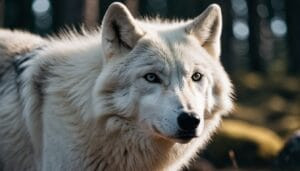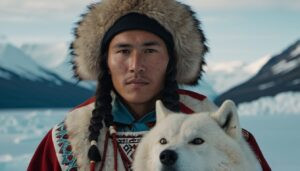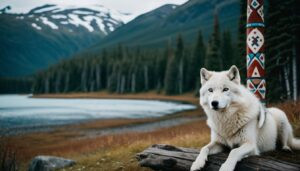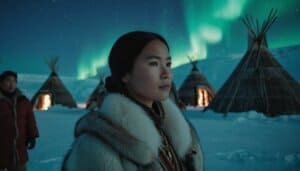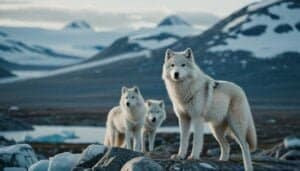Introduction
Arctic wolves have long been an integral part of Arctic myths, embodying a range of symbolic meanings and spiritual significance. These majestic creatures are deeply woven into the fabric of indigenous legends, often depicted as powerful and mystical beings
In this article, we will explore the common themes involving Arctic wolves in Arctic myths. We will delve into their symbolism, spiritual roles, and depictions in various legends. Additionally, we will examine how Arctic wolves interact with humans in these stories, the lessons they convey, and the notable wolf characters that have left a lasting impact on Arctic culture
Through this exploration, we aim to uncover the rich tapestry of beliefs and traditions surrounding Arctic wolves in the mythological landscape of the Arctic
Symbolic Meanings of Arctic Wolves in Arctic Myths
Arctic wolves hold profound symbolic meanings in Arctic myths, often representing various spiritual and cultural concepts. These creatures are revered for their strength, resilience, and adaptability, traits that are essential for survival in the harsh Arctic environment
This symbolism is reflected in numerous myths and legends passed down through generations of indigenous Arctic peoples
Symbolism of Arctic Wolves
In many Arctic myths, the Arctic wolf symbolizes endurance and survival. These wolves thrive in one of the planet’s most extreme climates, making them symbols of resilience and adaptability
They are also seen as guardians of the Arctic wilderness, embodying the untamed spirit of the region. The white fur of the Arctic wolf often represents purity and the ability to blend into the snowy landscape, symbolizing the harmony between the wolves and their environment
Spiritual Roles of Arctic Wolves
Arctic wolves are not just symbols of physical traits but also hold spiritual significance. Many Arctic cultures believe that these wolves possess spiritual powers and serve as guides or protectors
In Inuit mythology, for example, the Arctic wolf is often seen as a spirit animal that provides guidance and protection to individuals. The presence of a wolf in dreams or visions is interpreted as a sign of spiritual guidance, encouraging individuals to trust their instincts and stay true to their paths
Arctic Wolves in Creation Myths
Creation myths across various Arctic cultures frequently feature Arctic wolves. In some legends, wolves are seen as the creators of certain elements of the natural world. For instance, among the Inuit, there are stories where the Arctic wolf plays a crucial role in the creation of the landscape, shaping the mountains and valleys with its powerful movements
These myths emphasize the wolf’s integral role in the natural order and its connection to the very fabric of the world
Arctic wolves also often serve as mediators between the human world and the spirit world in these myths. They are believed to have the ability to traverse both realms, carrying messages from the spiritual to the physical world and vice versa. This dual role highlights their importance not only as physical beings but as crucial elements of the spiritual ecosystem in Arctic mythology
Depictions of Arctic Wolves in Indigenous Legends
Arctic wolves feature prominently in the legends and stories of indigenous Arctic peoples. These depictions vary across cultures, but common themes include their majestic presence, mystical abilities, and vital roles within the natural and spiritual worlds
These legends serve to pass down cultural values, survival knowledge, and spiritual beliefs through generations
Visual Representations
In the art and visual representations of Arctic cultures, Arctic wolves are often depicted with a sense of reverence and awe. Carvings, paintings, and other forms of artwork frequently show wolves in dynamic poses, capturing their agility and strength
These representations often highlight the wolf’s white fur and piercing eyes, symbolizing their purity and sharp awareness. Such artistic depictions are not merely aesthetic but carry deep cultural and spiritual significance, often used in rituals and ceremonies
Key Stories and Narratives
Arctic wolves are central figures in many key stories and narratives among Arctic tribes. For example, among the Inuit, there is a story about Amarok, a giant wolf that hunts alone at night
Unlike other wolves that hunt in packs, Amarok is a solitary creature, symbolizing independence and the mysteries of the night. This legend serves as a cautionary tale about the dangers of the Arctic night and the importance of respecting the natural world
Another prominent narrative is the tale of the Wolf Brothers, which tells of two wolf spirits who helped create the world and taught humans essential survival skills
This story emphasizes the close relationship between humans and wolves, suggesting that wolves have been teachers and protectors of humans since the beginning of time. Such stories are not just entertaining but serve to instill respect for the natural world and the wisdom it holds
Arctic Wolves in Inuit Mythology
Inuit mythology is rich with references to Arctic wolves, reflecting their significant role in Inuit culture and spirituality
One well-known myth involves the wolf as a guide for lost souls, helping them find their way in the afterlife. This underscores the wolf’s role as a spiritual intermediary, capable of navigating both the physical and spiritual realms
Another important myth is the story of Qimmit, the sacred wolf spirit, who is believed to have taught the Inuit how to work with and domesticate sled dogs. This legend highlights the practical and spiritual contributions of wolves to Inuit society, acknowledging the wolf as both a divine being and a crucial part of daily life
Through such stories, Inuit mythology weaves the presence of the Arctic wolf into the very fabric of existence, illustrating its importance in both the natural and spiritual worlds
Roles and Interactions of Arctic Wolves in Folklore
Arctic wolves are depicted in various roles and interactions in the folklore of Arctic peoples, illustrating their significance in both the natural and human worlds. These roles and interactions reveal much about the cultural values, survival strategies, and spiritual beliefs of Arctic communities
Interaction with Humans
In Arctic folklore, Arctic wolves often interact with humans in meaningful ways. These interactions range from cooperative relationships to cautionary encounters. One common theme is the wolf as a guide or protector
Stories often depict wolves leading lost hunters back to safety or protecting vulnerable individuals from other dangers in the wild. These tales underscore the belief that wolves possess a deep understanding of the land and a benevolent nature towards humans
Conversely, some legends serve as warnings about the dangers of the Arctic and the wild nature of wolves. For instance, there are stories about lone wolves or wolf packs attacking those who disrespect the natural order or venture too far into their territory
These narratives emphasize the importance of living in harmony with nature and respecting the boundaries of the wild
Lessons and Morals
Arctic wolf folklore is rich with lessons and morals that reflect the values of Arctic communities. Many stories convey the importance of resilience, cooperation, and respect for nature. For example, tales of wolves working together to hunt and survive teach the value of teamwork and the strength found in community
These stories are particularly resonant in the harsh Arctic environment, where survival often depends on cooperation and mutual support
Other moral lessons focus on respect for the natural world and the animals within it. Stories of wolves punishing those who harm the environment or overhunt teach respect for the balance of nature. These narratives often highlight the interconnectedness of all living things and the consequences of disrupting that balance
Influence on Cultural Practices
The roles of Arctic wolves in folklore have also influenced various cultural practices and traditions among Arctic peoples
For instance, the reverence for wolves is evident in the use of wolf imagery in art, clothing, and ceremonial objects. The wolf’s strength, cunning, and survival skills are admired traits, often incorporated into cultural expressions and rituals
In some Arctic communities, rituals and ceremonies are performed to honor the wolf and seek its guidance or protection. These practices may include offerings, dances, and songs that celebrate the wolf’s spirit and its significance to the community. Such rituals not only reinforce the spiritual connection to the wolf but also serve to maintain cultural identity and continuity
Additionally, the domestication of sled dogs, believed to have been influenced by the Arctic wolf, is a practical example of how wolf folklore has impacted daily life. The skills and knowledge passed down through wolf-related stories have contributed to the development of efficient and effective practices for living and thriving in the Arctic
Notable Arctic Wolf Characters in Arctic Mythology
Arctic mythology features several notable Arctic wolf characters that play crucial roles in the narratives and cultural beliefs of indigenous Arctic peoples. These characters often embody the qualities and symbolism attributed to Arctic wolves and are central to many myths and legends
Legendary Wolf Figures
One of the most renowned wolf figures in Arctic mythology is Amarok, a giant wolf from Inuit folklore. Unlike typical wolves, Amarok is a solitary hunter, symbolizing independence and the formidable power of nature
Amarok is often depicted as a guardian of the wilderness, punishing those who venture into the wild without proper respect or preparation. This character underscores the importance of humility and reverence when interacting with the natural world
Another significant figure is the Wolf Mother, a character found in various Arctic myths who is often portrayed as a nurturing and protective spirit. The Wolf Mother is believed to watch over and guide wolf packs, ensuring their survival and teaching them the ways of the wild. This character emphasizes the themes of maternal care, guidance, and the interconnectedness of life in the Arctic
Famous Myths Involving Arctic Wolves
One famous myth involving Arctic wolves is the story of the Wolf Brothers, two wolf spirits credited with creating key elements of the natural world. According to the legend, the brothers roamed the Arctic landscape, using their strength and wisdom to shape mountains, rivers, and valleys
Their actions are said to have created the diverse and challenging environment that Arctic peoples navigate today. This myth highlights the creative power attributed to wolves and their integral role in the natural world
Another well-known story is that of the Sacred White Wolf, a revered figure believed to possess extraordinary spiritual powers. The Sacred White Wolf is often depicted as a mediator between the human world and the spirit world, guiding souls and protecting the living
This myth reflects the deep spiritual significance of Arctic wolves and their role as guardians and guides in the Arctic belief system
Cultural Impact of These Characters
The characters of Arctic wolf mythology have had a lasting impact on the cultural practices and beliefs of Arctic peoples. The stories of Amarok, the Wolf Mother, and the Wolf Brothers, among others, are told and retold in various forms, including oral storytelling, art, and ceremonial rituals
These characters serve as powerful symbols and teaching tools, conveying important cultural values such as respect for nature, the significance of community, and the power of spiritual guidance
In addition to their roles in myths, these wolf characters are often invoked in rituals and ceremonies aimed at seeking protection, guidance, or blessings. For example, hunters may perform specific rites to honor Amarok, asking for safe and successful hunts
The Wolf Mother may be invoked in ceremonies related to family and community well-being, emphasizing her role as a protector and nurturer
The enduring presence of these characters in cultural expressions underscores their importance in maintaining the identity and continuity of Arctic cultures. They provide a connection to the past, offering lessons and wisdom that are still relevant today
Through the stories and rituals associated with these wolf figures, Arctic peoples continue to honor the profound relationship between humans and wolves, celebrating the shared qualities of strength, resilience, and respect for the natural world
Conclusion
Arctic wolves are deeply woven into the fabric of Arctic myths, embodying a variety of symbolic meanings and spiritual significance. Through the exploration of their roles and depictions in indigenous legends, we have uncovered their multifaceted presence in the cultural and spiritual lives of Arctic peoples
Arctic wolves symbolize resilience, survival, and the untamed spirit of the Arctic, often serving as guides, protectors, and intermediaries between the physical and spiritual realms
The legendary wolf figures such as Amarok, the Wolf Mother, and the Sacred White Wolf are central to many myths, highlighting the profound respect and reverence that Arctic cultures hold for these majestic creatures. These stories not only preserve important cultural values and survival knowledge but also reinforce the deep connection between humans and the natural world
In essence, the themes involving Arctic wolves in Arctic myths reflect the interconnectedness of life in the Arctic, the importance of respecting nature, and the spiritual guidance these wolves provide. Through their continued presence in stories, art, and rituals, Arctic wolves remain an enduring symbol of the strength, wisdom, and harmony that are essential to thriving in the Arctic environment


